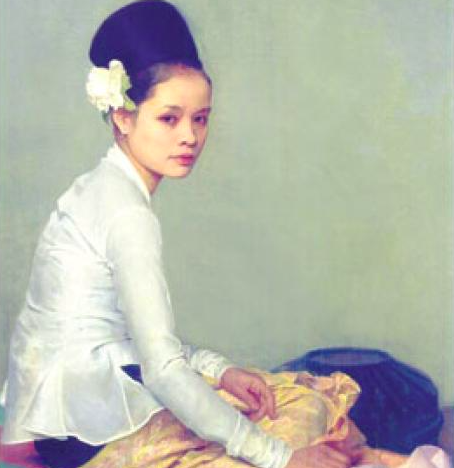I'm so happy to meet you as I journey! You may know that mermaids travel alone for long periods of time through vast watery spaces. What life we encounter along the way holds great value for us. In fact, our solitude nurtures our capacity to love you, dear human.
Burmese Mermaid

Burmese Pearl by Gerald Kelly
Friday, May 27, 2016
Once Upon a Time BBG, Part II - Aung San Suu Kyi (updated)
Giant photo projection in front of the European Parliament in Brussels:
"FREE Aung San Suu Kyi NOW
Sakharov prize 1990"
All that remains is the now defunct superstar image and a mystery of what might have gone wrong. Clearly, something went very, very wrong. The story of Aung San Suu Kyi is a disappointment, to say the least. How did a champion of human rights become an apologist for genocide?
Friday, May 6, 2016
Touch
"Often the hands will solve a mystery that the intellect has struggled with in vain." ~C.G. Jung
"And in that moment, he was finally able to accept it all. In the deepest recesses of his soul, Tsukuru Tazaki understood. One heart is not connected to another through harmony alone. They are, instead, linked deeply through their wounds. Pain linked to pain, fragility to fragility. There is no silence without a cry of grief, no forgiveness without bloodshed, no acceptance without a passage through acute loss. That is what lies at the root of true harmony."
From Colorless Tsukuru Tazaki, by Haruki Murakami
Thursday, May 5, 2016
Wednesday, May 4, 2016
Le Lumacche
Snails! They're what's for dinner.
My dear little land locked sea-bent creatures, my heart breaks for you at the thought of hungry Italians yearning for your tender flesh!
My Roman friend Nicoletta told me of how, after a spring rain, she and her Nonna Rosa would often go out into the suburban lots and country lanes to collect snails in metal pails. The tiny snails clung in clusters on low hanging branches, so it was very easy to run a hand along the branch and plonk, plonk, plonk, collect the falling snails in the pails. It was easy work. Within 20 minutes, the two of them could fill two good sized industrial pails.
At home, Nonna laid out lettuce and other juicy edible greens in a layer in a low, large plastic bin. Here, the snails were lovingly put to rest on the blanket of lettuce, and left to do their thing, which is nibble. They would inch their way around the bin and nibble and excrete, nibble and excrete. Snail heaven. Little did they know what awaited them.
After 24 hours of gorging and purging, the delicate creatures would be transferred to the kitchen sink and gently tossed with sea salt and allowed to rest for a few minutes. They were then vigorously rinsed in copious amounts of cold tap water.
The snails, now drained in the sink and squeaky clean, were placed in a large soup kettle with a generous splash of white wine. The lid was placed tightly on top of the pot, the heat was put on low, and the snails were lulled gently into a blissful eternal sleep. If the heat is low enough, each and every snail will stick out its head before oblivion comes calling.
Served in soup plates with good bread on the side, snails cooked in this manner are exquisite, I can assure you. With their little heads doing you the favor of sticking out of the shell, all you need to do is give a little slurp. Buon appetito, cara umana!
Venere Nascosta
Dance of Venus and the Earth around the Sun
The astrological Venus sometimes hides herself behind the veil of the last, twelfth house. When this occurs, the Burmese mermaid has observed that Beauty itself goes into hiding, as though dismissed or forgotten by the world. Banished. Venere nascosta.
But, astronomers engaged in the study of the physical universe have tracked Venus as she orbits around our Sun. Their findings reveal the nature of universal phenomena, also expressed as Beauty. The magic of numbers is visible all around us, all the time. But perhaps, dear Human, you have not evolved sufficiently to perceive the truth. The Burmese mermaid encourages you to stop and look profoundly at the world around you.
Watch as the combined paths of Earth and Venus create a five pointed star, also known as a pentagram. The earliest known pentagram was found inscribed on a jar, in Thebes, Egypt, and dates back to 3100 BCE.
Watch as the combined paths of Earth and Venus create a five pointed star, also known as a pentagram. The earliest known pentagram was found inscribed on a jar, in Thebes, Egypt, and dates back to 3100 BCE.
Tuesday, May 3, 2016
Badass Burmese Girls - Part I
Monday, April 18, 2016
Judgment of the Moon and Stars
As I searched the inky sky while floating on my back in the waters off the Great Barrier Reef, it occurred to me how completely a mermaid's life direction is guided by the Moon and stars and our star, the Sun. We use the luminaries for navigation but over the course of millennia the heavenly spheres have taken root in our hearts and souls as divine symbols.
In my travels, I have met astrologer mermaids in every ocean, unified by a quest for creating meaning from light and darkness stretching backwards and forwards in infinity.
My mermaid friend Evangeline, who lives primarily off the coast of Martha's Vineyard, told me about a man she knew on the island, a lyricist and poet by the name of E.Y. "Yip" Harburg. Yip wrote the lyrics to all of the songs in The Wizard of Oz, Pennies from Heaven, Brother, Can You Spare a Dime, April in Paris, It's Only a Paper Moon, and many more...
In my travels, I have met astrologer mermaids in every ocean, unified by a quest for creating meaning from light and darkness stretching backwards and forwards in infinity.
My mermaid friend Evangeline, who lives primarily off the coast of Martha's Vineyard, told me about a man she knew on the island, a lyricist and poet by the name of E.Y. "Yip" Harburg. Yip wrote the lyrics to all of the songs in The Wizard of Oz, Pennies from Heaven, Brother, Can You Spare a Dime, April in Paris, It's Only a Paper Moon, and many more...
“Words make you think. Music makes you feel. A song makes you feel a thought.”
~ E. Y. “Yip” Harburg
E.Y. Harburg
Yip was witty! Here is an example of his style, referencing star gazers:
"A broken clock can tell the time
correctly twice a day.
Astrologers, like broken clocks,
are clairvoyant that way."
What joy would there be in life if we could not laugh at ourselves? Astrologers are not exempt!
_______________________________________________________
What joy would there be in life if we could not laugh at ourselves? Astrologers are not exempt!
_______________________________________________________
Sunday, April 17, 2016
Are Mermen Real?
Stories of my male counterpart, the Merman, are well documented, and I can attest that Mermen are quite real. The Burmese Mermaid will always be scrupulously honest with you, dear human!
Unlike me and my sister mermaids, mermen are notoriously ugly and repugnant creatures. Surprisingly, they are also known to be wise and, sometimes, healers of men.
The merman's power is also destructive at times. I once knew a merman who caused a catastrophic shift in the current along the ocean floor that sent ships and ocean creatures crashing in distant shores.
And humans can be led astray by our singing voices, sometimes with fatal results. We mermaids and mermen can enchant and ensnare solely by the ethereal beauty of our voices.
We are also fascinated by human affairs, a realm that we should leave alone. The world of humans is not our world, nor does it represent our will. We cannot, as such, truly comprehend human motivations. When we do become dangerously curious of you, our essential nature is compromised. We may even die!
Jimi Hendrix: A Merman I Should Turn to Be
Rising Tides and Wishing Wells
While swimming together off the coast of Rangoon last winter, my Burmese mermaid sister Khin Thida spoke of Burma's decades of unrest, continuing human rights abuses, most recently of the Muslim Rohingya people, the confinement of political prisoners, and tentative hopes that democracy will take root where there has been no civil society for over half a century. Our tears for Burma flowed and became one with our Mother ocean.
Burmese women sit Asian style
squat, knees to chins,
sarongs crumpled around fair legs.
They exchange words on markets
and husbands and children.
They may walk to town in the hot noon sun.
The jungle steams behind their backs
Hissing and spotted,
alive with poison,
and among the banyans,venomous eyes
and crying elephants laboring in the dust.
Down by the Irrawaddy, fishing boats come.
At the train station, a boy from Dehra Dun
And in his eyes are English boarding schools and beggars
And snow capped Himalayas.
Village women pass with jasmine
woven through black hair.
The scent of frangipani lingers after them.
Soon the monsoons will come to wash
the dust from the dry earth.
At dusk, the women walk toward home
down Mandalay Road.
The jungle hisses in the night.
The train from Dehra Dun arrives with the boy
but his hair is gray now
and his eyes have seen more
than English boarding schools and beggars
and snow capped Himalayas.
Monday, April 11, 2016
Birth of a Mermaid
"I must be a mermaid, Rango. I have no fear of depths and a great fear of shallow living."
~ Anais Nin
Teeny tiny mermaid I once was too, curled inside a scallop shell, rocked in the arms of our mother Ocean. Timeless ages passed, then one day the shell cracked opened - to light and sand and salty waves. In that moment, I was born!
A mermaid is born only when rescued by a loving human hand. Otherwise, she remains forgotten in the timeless ocean tides. Human touch releases us from our captive shell and we are born and come alive.
Subscribe to:
Posts (Atom)
















